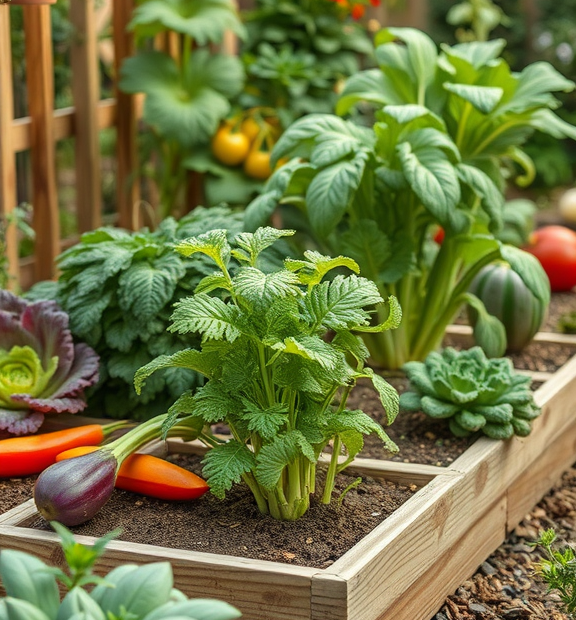Creative Veggie Garden Ideas for Small Spaces
Creating a veggie garden in a small space can be both exciting and rewarding. You don’t need a sprawling yard to grow fresh vegetables; with some creativity, you can transform even the tiniest area into a thriving garden. Let’s explore some innovative ideas that will help you make the most of your space while bringing joy and freshness to your meals.
Vertical Gardening Solutions
Vertical gardening is a fantastic way to maximize your growing area. By planting upwards, you save ground space and enhance aesthetics. Here are a few ideas:
- Wall Planters: Use sturdy shelves or wall-mounted planters to create a living wall. Choose herbs like basil, thyme, or parsley for easy access.
- Hanging Baskets: Suspend baskets from hooks or ceilings. Popular veggies for this method include strawberries and cherry tomatoes, which cascade beautifully.
- Pallet Gardens: Repurpose old pallets into vertical gardens. Fill each section with soil and plant your favorite greens, like lettuce or spinach.
Container Gardening Ideas
Containers can transform patios, balconies, or even window sills into vibrant veggie gardens. Here are some creative container options:
- Edible Planters: Select attractive containers like large ceramic pots or wooden barrels. Plant potatoes, carrots, or dwarf beans for a rustic look.
- Repurposed Items: Use items such as old boots, tin cans, or wine crates as quirky planters. Just ensure they have proper drainage holes.
- Tiered Stands: Invest in a tiered plant stand to utilize different levels. This allows for varied heights and better sunlight capture.
Herb and Veggie Mix
You can efficiently combine herbs and vegetables in the same planting space. Some companion plants not only save space but also improve each other’s growth. Consider these pairings:
- Tomatoes and Basil: Tomatoes thrive when planted with basil, which aids in pest control and enhances flavor.
- Carrots and Onions: These two love growing together, as onions naturally deter carrot pests.
- Peppers and Marigolds: Planting marigolds alongside peppers can help repel harmful insects.
Utilizing Every Nook
Make use of every nook and cranny in your space. Even the most seemingly unusable spots can be transformed into veggie patches:
- Railings and Balconies: Attach rail planters to balcony railings for an elegant touch that allows you to grow herbs or flowers.
- Gutter Gardens: Old gutters can be cut and mounted vertically along a wall to create an unusual garden space.
- Fences and Trellises: Use fences or trellises to support climbing plants like cucumbers, peas, or beans.
Seasonal Planting and Succession Gardening
To maximize your yield in a small garden, practice seasonal planting and succession gardening. This simple practice keeps your garden productive year-round:
- Plan Ahead: Research which vegetables grow well in your climate and plant them accordingly. Cool-season crops like spinach can be planted in early spring, while warmer vegetables like squash can follow.
- Staggered Planting: Plant a new batch of fast-growing crops every couple of weeks. For example, sow more radishes every two weeks for a continuous supply.
Community and Shared Gardening
If space is limited, consider getting involved in a community garden. These gardens allow you to share a larger growing area with neighbors, which is both fun and productive.
Love what I do? Be a hero and help me keep creating awesome content!
Support My Mission Now!Every donation fuels more great stuff – thank you, legend!
Alternatively, look into shared spaces with friends or family. You can take turns tending to the plants, ensuring that everyone enjoys the fruits (and vegetables!) of your labor. This arrangement can foster a sense of community while providing support and sharing gardening tips and tricks.
Crafting a veggie garden in a small space doesn’t have to be a challenge. With these creative ideas, you can enjoy the pleasure of gardening and savor fresh produce right from your own home. Embrace the possibilities, and let your small space flourish!
Tips for Enhancing Soil Health in Your Veggie Garden
Love what I do? Be a hero and help me keep creating awesome content!
Support My Mission Now!Every donation fuels more great stuff – thank you, legend!
When it comes to growing a thriving veggie garden, healthy soil is your best friend. It’s the foundation of your plants’ health, promoting vigorous growth and delicious produce. Here are some effective tips to enhance the soil health in your veggie garden. Each tip will not only improve soil quality but also boost your gardening success.
Understand Your Soil
Before making changes, it’s essential to know what type of soil you have. Take a soil test to determine its pH, nutrient levels, and structure. This information will guide you in amending your soil effectively. You can purchase a testing kit or send a sample to a local extension service. Understanding your soil type will help you to enhance its properties more efficiently.
Add Organic Matter
One of the best ways to improve soil health is by adding organic matter. Organically-rich soil holds nutrients and retains moisture better. You can achieve this through:
- Compost: Regularly mix compost into your soil. It nourishes plants and improves soil structure.
- Leaf Mold: Decomposed leaves can enrich your soil, providing essential nutrients.
- Age Manure: Well-aged manure can be a fantastic boost to garden soil, just make sure to use it wisely to avoid burning plants.
Rotate Your Crops
Love what I do? Be a hero and help me keep creating awesome content!
Support My Mission Now!Every donation fuels more great stuff – thank you, legend!
Crop rotation is a simple yet effective technique to maintain soil health. By changing the location of specific crops each year, you can prevent nutrient depletion and manage pests and diseases. Here are some points on how to implement this method:
- Group plants into families and rotate them annually.
- Follow heavy feeders like tomatoes with light feeders like lettuce.
- Consider planting cover crops in off-seasons to replenish nutrients.
Practice No-Till Gardening
No-till gardening improves soil structure and health. Instead of digging and turning the soil, this method allows you to build healthy layers over time. Here’s how to get started:
- Layer organic materials like straw or grass clippings on top of your garden.
- Plant seeds directly into the compost layer.
- Over time, the layers will break down, enriching the soil without disturbing its natural ecosystem.
Incorporate Cover Crops
Love what I do? Be a hero and help me keep creating awesome content!
Support My Mission Now!Every donation fuels more great stuff – thank you, legend!
Cover crops, or green manures, are plants grown to improve soil health rather than for harvesting. They protect the soil from erosion and add vital nutrients. Some great options include:
- Clover: Fixes nitrogen in the soil.
- Vetch: Provides a good source of organic matter.
- Rye: Helps in controlling weeds while adding valuable nutrients when tilled under.
Improve Drainage
Proper drainage is vital for soil health. Waterlogged soil can suffocate roots and lead to root rot. To improve drainage, consider:
- Creating raised beds to elevate your plants.
- Adding sand or gypsum to improve soil structure.
- Using a French drain if your garden tends to retain water.
Limit Soil Compaction
Compacted soil restricts root growth and reduces water infiltration. Here are some ideas to prevent soil compaction:
- Avoid walking on garden beds.
- Designate paths to access different parts of your garden.
- Use mulch to cover bare soil, which helps retain moisture and protects from compaction.
Maintain Soil pH
Soil pH affects nutrient availability and the type of crops you can grow. Most veggies thrive between a pH of 6.0 and 7.0. If your soil is too acidic or alkaline, you can amend it by:
- Adding lime to raise the pH.
- Using sulfur to lower the pH.
- Regularly testing your soil pH to monitor changes.
By implementing these tips, you can enhance the soil health in your veggie garden, resulting in stronger plants and a bountiful harvest. Remember, healthy soil is the key to a thriving garden, so invest your time and effort for rewarding results.
Conclusion
Creating a veggie garden, even in a small space, can be an incredibly rewarding experience. By utilizing creative solutions like vertical gardening, container gardening, or even window boxes, you can maximize your gardening potential without needing a large area. These simple ideas allow you to grow fresh vegetables while adding beauty to your home and environment.
Moreover, the health of your soil plays a vital role in the success of your veggie garden. Implementing techniques such as composting, crop rotation, and the use of organic matter can significantly boost nutrient levels, ensuring your plants thrive. Healthy soil not only supports robust growth but also enhances the flavor of your vegetables, creating a more enjoyable harvest.
By combining these creative gardening ideas with effective soil enhancement strategies, you can cultivate a thriving veggie garden that meets your needs, regardless of space constraints. Whether you’re an experienced gardener or a beginner, these tips empower you to transform even the smallest areas into productive edible landscapes. Remember, regardless of the scale, every effort you make contributes to a greener, healthier lifestyle and brings the joy of homegrown produce to your table. Embrace the journey of gardening, and let your creativity shine through as you explore endless possibilities for your veggie garden.

